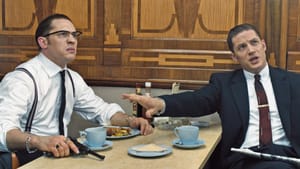Stay in the Loop
BSR publishes on a weekly schedule, with an email newsletter every Wednesday and Thursday morning. There’s no paywall, and subscribing is always free.
Two for the price of one
Brian Helgeland's 'Legend'

London in the 1960s was ripely decadent: an imperial capital that had lost its empire, and in which scandal high and low proliferated. The film that summed it up at the time was Michelangelo Antonioni’s Blow-Up. British director Brian Helgeland revisits the terrain in Legend, focusing on the two most notorious characters of the decade, the Kray brothers, who dominated London’s gang life and a good part of its social scene.
Reggie and Ronnie Kray were identical twins who, coming out of the city’s East End, muscled out rivals and gained, for a time, a virtual monopoly on its casinos and nightclubs, upscale as well as down. Their reach was international, including an alliance with Philadelphia’s mob boss Angelo Bruno and a bizarre development project in Nigeria, Ronnie Kray’s brainchild. Murder convictions finally did them in, but not before their connections had reached the highest levels of the British establishment and posed a threat to Harold Wilson’s Labour government.
Well, it was the ’60s, and the Kennedy administration was riddled with mob associations too. Frank Sinatra, an equal-opportunity entertainer to the underworld, was chummy with the Krays as well as the Kennedys, and at one point was protected by a platoon of bodyguards provided by the Krays. It was a period of mob wars in the States, too, as Philadelphians of a certain age can attest. But the Krays were in a league of their own for personal violence, and the fear they struck in London for a few years had not been experienced since the days of Jack the Ripper. That, of course, was part of their aura.
Good brother, bad brother?
The Krays’ story has been filmed before, but Helgeland offers a novel twist in having a single actor, Tom Hardy, portray both brothers. The script, also by Helgeland, makes Reggie a sensitive sort who winningly courts a local girl, Frances Shea (Emily Browning), and shows distaste for Ronnie’s homicidal outbursts. Ronnie is a business problem, too, and his openly flaunted homosexuality wrecks their flagship nightclub while Reggie is away on a prison stint.
This isn’t to say that Reggie is any blushing violet when it comes to brass knuckles, and a scene in which the brothers take on a rival gang in a bar is as brutally violent as any ever depicted onscreen. But Reggie knows where to draw the line, and Ronnie — in Hardy’s taut performance even more frightening at rest than in action — is a time bomb ready to explode at any moment.
The real-life Krays were about equally violence-prone, although Ronnie was actually the psychotic one. Their sexual proclivities were also much less distinct; both were bisexual. In choosing to contrast them so strongly, Helgeland pitches their personality differences as the core of his story. Reggie finally destroys Frances (whose death is depicted as a suicide, although some have said that Ronnie killed her), and then drags himself down in a spasm of violence that proves his undoing. We are supposed to see tragedy in this, and Hardy’s Reggie makes this persuasive.
Post-imperial Britain
But there would have been another way to play the story, one closer to the historical truth: to see the Krays as icons of their time, and to reveal the corruption of post-imperial British society through them. There is a moment in which Helgeland seems to be setting something like this up, when a shot of a country lane is overlaid with the voice of Winston Churchill delivering his famous speech before the Battle of Britain vowing to resist Hitler to the end. But Helgeland misses his own chance to go for the jugular here, settling instead for something smaller and more conventional.
This means that Hardy’s dual performance, despite a strong supporting cast that includes an excellent cameo by Chazz Palminteri, must carry the thrust of the film. Hardy is so good that we buy his Jekyll-and-Hyde premise, but, as I say, that is the film’s limitation as well as its strength.
Suggested, but also underdeveloped, is the theme of class tension. For the underclass, crime is the most immediate way out of poverty, and the Krays’ success showed how rapid a rise was possible in an era of social unrest or decline. At the height of their power, they were actual celebrities, and even in prison they retained a certain cachet (as well as some still-flourishing enterprises).
What we see of this in Legend is the Krays’ nostalgia for their East End origins, but that is finally a way to soft-pedal the issue of class, too. Still, there’s at least a stab here at exposing the underside of the ’60s. American films have never gotten past the Easy Rider view of what that still-critical decade was about. When is Oliver Stone (or somebody) going to give us The Kennedys, about that remarkable moment when the mob actually made it to the White House?
What, When, Where
Legend. Written and directed by Brian Helgeland. Based on the book The Profession of Violence by John Pearson. Currently playing at the Ritz at the Bourse, 400 Ranstead Street, Philadelphia.
Sign up for our newsletter
All of the week's new articles, all in one place. Sign up for the free weekly BSR newsletters, and don't miss a conversation.

 Robert Zaller
Robert Zaller